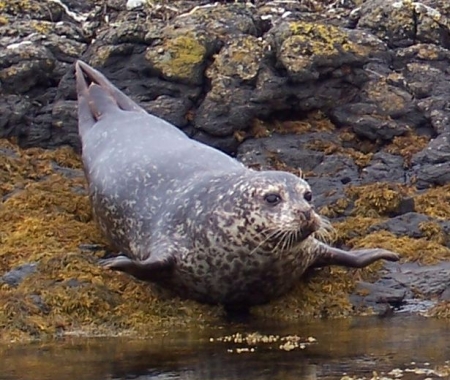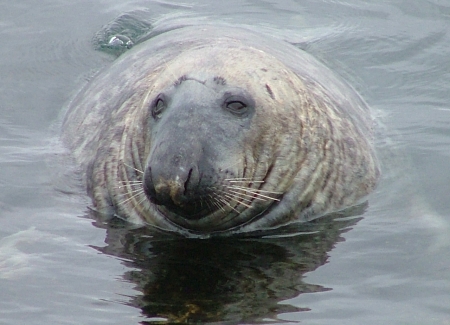There are two types of seal found around the British Isles – the common seal and the grey seal. Both are relatively common and are even seeing their numbers increase – an issue which some say is responsible for reducing fish stocks (read more about seals and sea fishing in this article). Other species of seals, such as the harp seal, hooded seal and ringed seal are very occasional visitors to the British Isles but any sightings of these species are extremely rare and confined to the colder waters of northern Scotland.
Common Seal

- Scientific name: Phoca vitulina
- Also know as: Harbour Seal
- Size: Up to six feet in length and 300lbs.
- IUCN Status
- Global: LC (Least Concern)
- Europe: LC (Least Concern)
- Distribution: Common around the British Isles and the colder waters of most of Northern Europe. Also common in North American waters with smaller populations elsewhere in the world.
- Feeds on: Mostly fish and squid with all species being taken. May also consume other sources of food which become available such as crabs, lobsters and even marine birds.
- Description: Large powerful fat body with relatively small flippers. Relatively small head with large eyes and nostrils which are close together. The mouth is full of small but sharp teeth. Colour can vary greatly. Usually greyish but this can be a lightish, almost white to a dark near-black colour, while other common seals can be a brown/tan colour. Speckled/spotted colour is present across the back and body.
Common seals are – as the name suggests – the most common type of seal found around the UK. Although they are found all around the coastline of the British Isles the highest populations are found around Scotland and along the eastern coast of England. They are also found throughout the colder waters of northern Europe. They are non-migratory animals which spend their lives close to the shore, rarely venturing more than a few miles out to sea. Common seals live in large groups and can make their home on a variety of different shorelines ranging from sandy beaches and sandbanks to fairly rocky and rugged coasts. However, common seals spend the majority of their time in the water. They are capable of diving to depths of several hundred metres and can remain submerged for over half an hour.

Common seals are unfussy predators which will hunt and eat any type of fish which is available with pelagic (mid-water) species such as mackerel being taken as well as demersal (bottom-dwelling) species such as cod, haddock and plaice all being preyed upon. They will also feed on other food sources which present themselves with common seals being known to eat squid, cuttlefish, crabs, lobsters and even marine birds at times. Females give birth in the summer months after a nine-month gestation period. While the young have an innate ability to swim they are still cared for by their mothers for around two months and rapidly put on weight due to the fatty milk the mother produces. All common seals go through a moulting process after breeding and must spend a longer proportion of time on land during this time.
Grey Seal

- Scientific name: Halichoerus grypus
- Also known as: Horsehead Seal
- Size: Males can be 10ft long and 800lbs, females 6ft in length and 300lbs.
- IUCN Status
- Global: LC (Least Concern)
- Europe: LC (Least Concern)
- Distribution: Found mostly around the north of the British Isles. Also distributed throughout Scandinavian and northern European waters with other populations in North America and an isolated population is present in the Baltic Sea.
- Feeds on: Fish and squid along with crustaceans and pretty much any other sources of food which are present.
- Description: Blubbery but powerful body, which is usually dark grey in colour. Longish snout with large eyes and nostrils which are spaced apart.
The grey seal is a species which is found around the colder northern regions of the British Isles. There are notable breeding colonies in a number of places around the UK such as off the coast of Northumberland, Lincolnshire and the Orkney Islands. The grey seal is a species which grows to much larger sizes than the common seal, with males being substantially larger than females. The main difference between the two species of seal is that the grey seal has a much longer snout than the common seal, and the nostrils of the grey seal are spaced far apart, while they are close together in the common seal.

Like the common seal the grey will hunt for all manner of fish species but will also take squid, crustaceans and other sources of food which present themselves. They live in large colonies which can consist of thousands of individual seals, with seals hauling-out (leaving the water) to rest and bask after they have been hunting. Females give birth in late summer/early autumn and care for their offspring for a number of weeks until the soft white fur of the young has been replaced by the adult’s waterproof fur. Numbers of grey seals are on the rise across the world, leading to concern in some quarters over the impact this will have on fish stocks.
Related Article: Seals and Sea Fishing
Hunting and Culling Seals
Humans have hunted seals for thousands of years. There is evidence that ringed seals (Pusa hispida) have been hunted in Canada for over four thousand years. Seals were harvested intensively throughout Canada, Alaska and Europe throughout the 1700s. In the 1800s the development of steam-powered ships which had the ability to break through ice allowed the hunting of seals to massively expand, and 1872 saw almost 750,000 seals killed in the Gulf of St. Lawrence and Newfoundland area alone.

Today seals are still hunted commercially by six nations: Greenland, Iceland, Norway, Canada, Russia and Namibia (which is the only Southern Hemisphere country which hunts seals).

The Canadian quota of seals which are killed in the annual seal hunts has been rising in recent years as the value of seal products has gone up. In 2015 the quota was set at almost 500,000 seals, with harp seals, hooded seals and grey seals making up the majority of the quota. The Canadian seal hunt is subsidised by the government and environmental campaigning bodies campaign strongly against the actions of the Canadian government and attempt to draw public attention to the hunting of seals (see below). Norway is responsible for killing around 30,000 seals per year and Russia accounts for around 5000 – 6000 seals. The vast majority of seals are killed with guns and firearms, although some are still killed in the traditional manner with an axe-like tool known as a hakapik. Seals are not hunted in the United Kingdom, although licences can be granted to shoot seals if they threaten the stocks of fish farms (see below).

Seals have many uses for humans. Their flesh can be eaten although it only has a market in isolated coastal communities around the world where it has been consumed for generations. The skin can be used to make boots, clothes and waterproof material, while the blubber can also be used to make oil supplements similar to cod liver oil tablets. In the past the oil from seals was also used to make lamp oil.

Today no mainstream supermarkets sell seal meat and major fashion brands do not use seal fur due to the ethical issues and negative reaction from consumers. In both Britain, the USA and Canada there are often plans put forward for a general seal cull in order to protect fish stocks. While this may seem logical there is little scientific evidence to back up the claim that fewer seals mean more fish (as other fish predators such as birds, whales, dolphins and other fish would simply eat more) and campaigners have claimed that plans to cull seals in Canada to protect fish stocks are ineffective, cruel and pointless.
In Britain, seals are protected through the Conservation of Seals Act 1970. However, seals are still culled in Britain with several hundred seals killed in Scotland by the owners of fish farms in order to protect their stocks. While a license is needed to cull seals in the UK it has been noted that seals can be culled all year round (including during the breeding season) and it has been claimed that the unregulated and unverified nature of seal culling in the UK means that the true number of seals killed could be much higher.
Campaigns Against the Hunting of Seals

The hunting of seals is highly controversial with a number of environmental and conservation campaign groups strongly campaigning against this practice. These groups highlight the fact that there is no need for most nations to hunt seals for food, raise concerns the ethics of killing intelligent and sentient mammals and also question the scientific basis for claims that seal numbers are healthy and will not be impacted by hunting these species. The Canadian harp seal (Pagophilus groenlandicus) hunt comes in for particular criticism with charities such as Sea Shepherd producing detailed reports on why they believe the Canadian seal hunt is unacceptable and should be stopped.